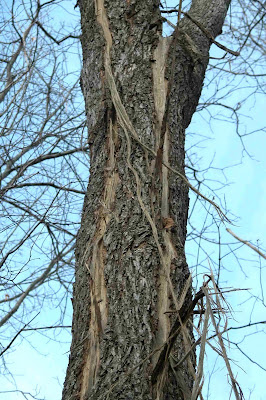About 120 OOS participants and guests scoured The Wilds Saturday, January 19, 2008. Organizers Marc Nolls and Cheryl Harner assembled eight teams with skilled leaders, and excellent maps and descriptions, and they scheduled teams in a rotation through commanding observation locations through the day. Everyone had a chance to see great birds. The great birds made their rounds, too. Team radios crackled updates and whereabouts: "A Golden Eagle is going east between Jeffrey Point and the Visitors Center." and "Merlin over the parking lot!"
It felt like a day on the high plains of
Hawks and falcons scribe lines and spirals in the sky, and suspend high over mousy fields as if held in place by kite strings. A tweaking of wing angle and tail position, an occasional flurry of shallow wing-flaps, and their continuing exquisitely skilled fine adjustments of wing-extension and alulae position keep the soaring birds in place, no strings attached. The wings of raptors know the breeze, and it's a wonderful thing to watch them soar.
My team saw numbers of beautiful Rough-legged Hawks in both light- and dark-morph plumages. These boldly patterned chunky small-footed lemming specialists from the tundra seemed right at home in The Wilds.
Northern Harriers were especially abundant through the day. Their nonchalance; their buoyant frolicking, winging over grass-tips, teetering for better hearing of squeaky voles, allowed an easy close look and an entertaining spectacle. Occasionally, an immaculate white and ice-gray colored male sporting ink-dipped wing-tips wandered through our view and we were awed by nature's perfected art.
Raptor numbers are high in wintering areas this season, due to low rodent populations in more northern areas. We saw high numbers of raptors.
I most enjoyed the Golden Eagle as it perched on a large sycamore branch overlooking the stretched pond below the visitor's center. Wind ruffled its golden hackles as it peered eagle-eyed across the landscape. Maybe it was interested in the Ring-necked Ducks, the American Black Ducks or Mallards, or the collar-banded Trumpeter Swans? I wonder if eagle predation effects reproduction among any of the globally rare species conservation biologists support and study at The Wilds? I’m sure there is room for both eagles and rare ungulid grazers in these wide-open spaces.
The best show of the day came at lunchtime for the first lunch-shift. Al Parker, Conservation Educator for The Wilds presented his illustrated tour of raptors found through the seasons at The Wilds while birders lunched in warmth behind glass. Right on cue, stage-left, enters a Golden Eagle, flying at eye-level, peering into the center through the glass while a gathering of birders peered out at the passing eagle (So I was told: I was in the second lunch group).
The Wilds is a pond-spangled grassland spanning 10,000 acres in the topsy-turvy landscape of coal country in
History is the best window for viewing a place. The biological history of Ohio coal country once was defined by forest giants and giant flocks of pigeons, Passenger Pigeons, now extinct. Today, humans rule. Modern anthropogenic paroxysms have reshaped the hills of coal county. Within just two-hundred years, the collective half-life of the once-upon-a-time forest giants, we have seen landscape change rivaling the Pleistocene. We rout that change.
Throughout The Wilds and beyond award-winning reclamation converted mining spoil to grassy turf, and small rodents found the new habitat. Now microtine rodents tunnel the turf, and abundant raptors listen and watch for a favorite meal; chubby meadow voles squeaking through the grass: A new ecology is introduced here.
The enormous biological diversity of the original mixed-mesophytic forest will never return to these hills, but so long as there are wide open grasslands with voles, the wind-dancers will return, and these new hills will host their simple new ecology.




